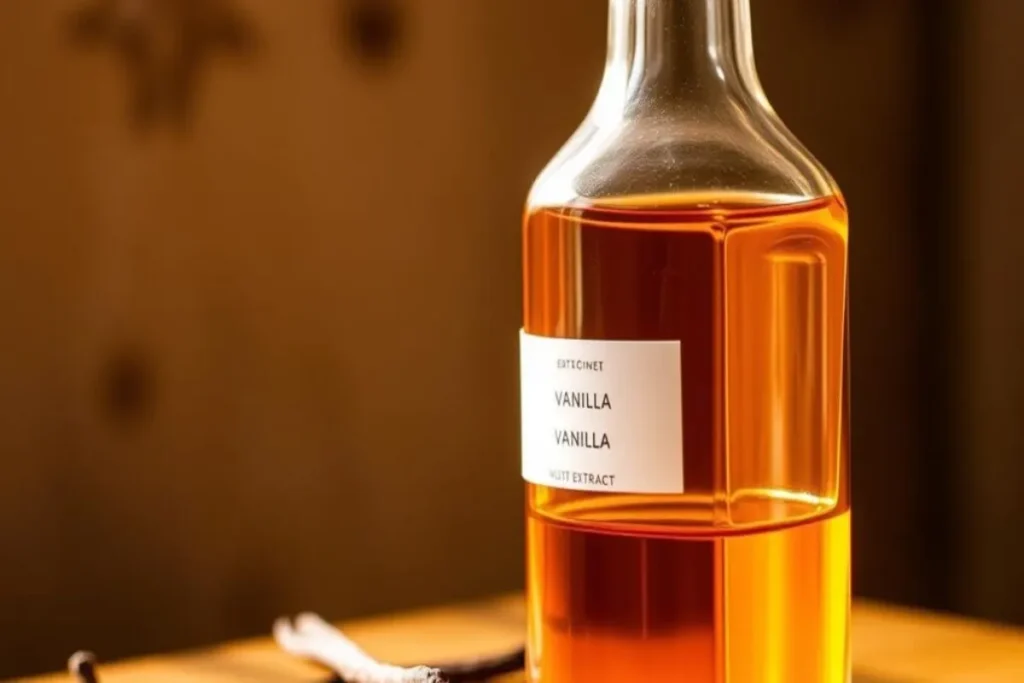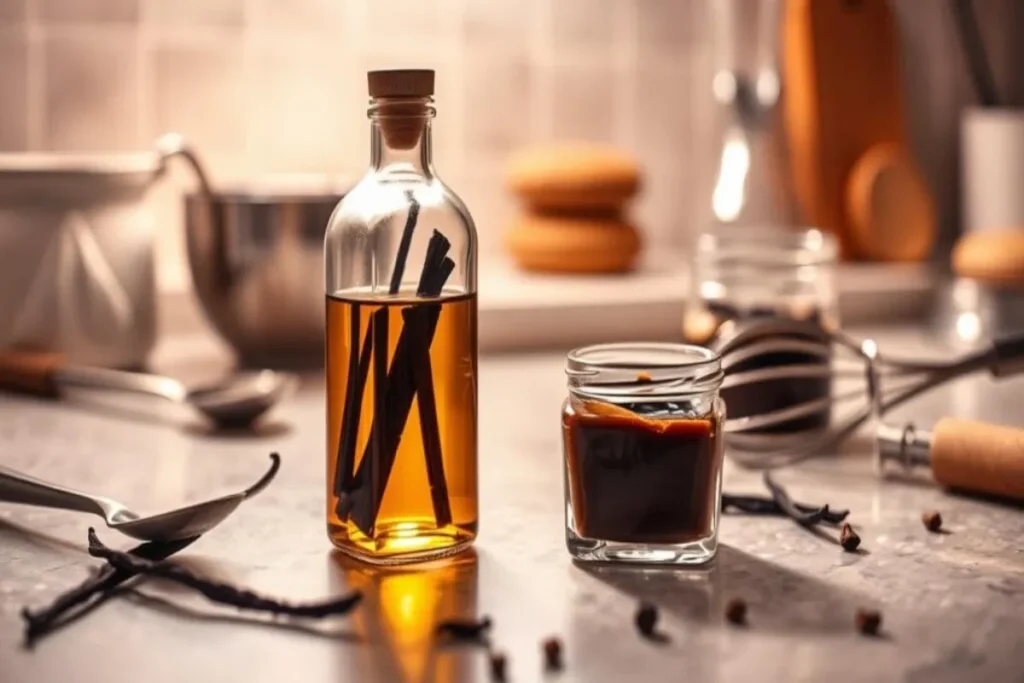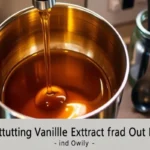Do you remember baking with a loved one in the kitchen? The smell of Vanilla Extract vs Paste Substitutionwas more than a scent. It brought back happy memories. Choosing between vanilla extract and paste can be tough. They each have their own special place in cooking.
Understanding their differences is key. We’ll look at how swapping vanilla extract for paste changes your recipes. This way, you can make delicious dishes that feel like home. It’s all about exploring the world of vanilla and making choices that keep those memories alive.
Table of Contents
The Importance of Vanilla Extract vs Paste Substitution
Vanilla is a key ingredient in baking, known for boosting the taste of many treats. It does more than just add flavor; it balances and enhances other ingredients. This creates a perfect harmony of tastes that makes desserts special.
Vanilla’s warmth and subtlety make it a must-have in many recipes. It’s a key part of many beloved dishes.
Understanding Vanilla-Paste Role in Flavor
Vanilla is essential in many recipes, adding depth and sweetness. It’s used in cookies, cakes, and custards, bringing a soothing complexity. Vanilla’s delicate notes can be the main attraction or blend well with chocolate or fruit.
Knowing how vanilla affects flavors helps you make unforgettable treats. These treats are not just tasty but also memorable.
Different Forms of Vanilla-Paste Used in Cooking
There are several types of vanilla, each with its own taste and intensity. The most common include:
- Vanilla Extract: Made by soaking vanilla beans in alcohol, it has a full flavor. It’s great for most recipes.
- Vanilla Bean Paste: This is made by mixing vanilla seeds with a gelling agent. It’s thicker and has visible seeds, adding flavor and looks.
- Vanilla Powder: Made from dried beans, it’s a concentrated flavor without liquid. It’s a 1:1 substitute for extract.
- Whole Vanilla Beans: Perfect for strong vanilla flavor, these beans must be plump and shiny. Quality is key.
Knowing the differences between vanilla types lets you be more creative in baking. The right vanilla can make a big difference, ensuring your desserts are a hit.
What is Vanilla-Paste Extract?

Vanilla extract is a key ingredient in many recipes. It’s known for its rich aroma and versatility. It’s made by soaking vanilla beans in alcohol, capturing their essence. Knowing how Vanilla-Paste extract is made can improve your baking.
How Vanilla Extract is Made
The making of vanilla extract is a detailed process. Vanilla beans, mainly from Vanilla planifolia and Vanilla tahitensis orchids, take months to grow. After harvesting, they’re soaked in alcohol for months to extract their flavors.
The final product must have at least 35% alcohol to be pure vanilla extract. This ensures its quality and flavor.
Flavor Profile and Uses of Vanilla Extract
Vanilla extract has a complex, sweet flavor. It’s more natural than artificial vanilla, which is made from guaiacol. Pure vanilla extract is better for adding depth to recipes like cakes and cookies.
Its clear consistency makes it perfect for mixing into batters and liquids. This ensures your dishes look as good as they taste.
| Characteristic | Vanilla Extract | Artificial Vanilla |
|---|---|---|
| Source | Natural vanilla beans | Synthesized from guaiacol |
| Flavor Profile | Complex and nuanced | One-dimensional |
| Usage Ratio | 1 teaspoon = 1 teaspoon | 2 teaspoons = 1 teaspoon |
| Appearance | Clear and smooth | Variable |
| Best Uses | Baking, beverages | Baking where flavor is secondary |
What is Vanilla-Paste?
Understanding vanilla paste is key to improving your cooking. It adds a rich, aromatic flavor and looks great in dishes. Made from crushed vanilla beans, seeds, and pods, it has a thick, velvety texture.
Composition and Characteristics of Vanilla Paste
Vanilla paste is special because of what it’s made of. It has tiny specks of vanilla seeds, adding flavor and beauty to food. It’s thicker and more intense than vanilla extract, giving dishes a stronger vanilla taste.
One tablespoon of vanilla paste is like one vanilla bean or one tablespoon of extract. This makes it easy to use in different recipes.
When to Use Vanilla Paste in Recipes
Vanilla paste is perfect for recipes where vanilla is the main flavor. It’s great in desserts like crème brûlée, custards, and vanilla bean ice cream. Its deep flavor makes these dishes stand out.
The speckled look of vanilla paste also makes dishes look fancy. It’s a great choice for recipes that need a strong vanilla taste. It improves both the taste and look of your food.
Can You Use Vanilla Extract as Vanilla-Paste?

Ever wondered if you can swap vanilla extract for vanilla paste in a recipe? The good news is yes, you can. But, it’s important to know about the right amounts and how the flavors might differ.
Substitution Ratios for Baking
For baking, you can use the same amount of vanilla extract as vanilla paste. So, one teaspoon of each is okay. But, if you want a stronger taste, you can use double the vanilla extract. Just remember, changing the liquid can affect your recipe’s texture.
Flavor Implications of Using Extract Instead of Paste
Switching to vanilla extract changes the flavor of your dishes. Vanilla paste has a deeper taste, thanks to the vanilla bean seeds. On the other hand, vanilla extract is milder. It’s better for recipes where vanilla is just a hint, not the main flavor.
In short, you can replace vanilla paste with extract, but the amounts and tastes will differ. Keep these tips in mind to make your recipes a hit every time.
Comparing Vanilla Extract and Vanilla-Paste
Vanilla extract and vanilla paste are more than just choices; they change how your food tastes and looks. Each has its own special qualities that can make your dishes better.
Flavor Intensity Differences
Vanilla paste has a stronger taste, perfect for desserts like crème brûlée or vanilla bean ice cream. Vanilla extract, on the other hand, adds a rich yet subtle flavor. It’s great for recipes where vanilla is just a hint, like in cookies.
For desserts that want to show off vanilla, like custards and ice cream, vanilla paste is the way to go. It adds a beautiful touch with its visible specks. Vanilla extract, being clear, is better for dishes that need a uniform look.
How to Use Vanilla-paste Extract Instead of Vanilla-Paste
Switching to vanilla extract can make baking better. Knowing how to adjust ensures your recipes turn out great.
Adjusting Liquid Content in Recipes
Using vanilla extract means you need to adjust liquids. It’s thicker than paste, so you might cut down other liquids a bit. For example, if a recipe uses one tablespoon of paste, use one tablespoon of extract instead. Remember, extract adds more liquid, so watch the balance to keep your dish right.
Timing for Incorporating Vanilla Extract
When you add vanilla extract is key for flavor. Add it at the same time you would the paste. This lets the flavors mix well with other ingredients. For strong vanilla flavors, add it early. For a light touch, adjust the timing a bit.
Knowing how to use vanilla extract instead of paste makes your baking better. It ensures your treats are always delicious.
Other Vanilla Substitutes to Consider
When you’re baking, you might look for other flavors to use instead of vanilla paste. There are many options that can make your food taste great. You could try using whole vanilla beans, vanilla powder, or vanilla sugar.
Whole Vanilla-paste Beans and Pre-Scraped Seeds
Whole vanilla beans add a deep flavor and a nice texture to your dishes. If you split and scrape one, it’s like using 1 tablespoon of vanilla extract. This way, you get a natural taste that goes well with both sweet and savory foods.
Using Vanilla-paste Powder and Vanilla Sugar
Vanilla powder is made from ground vanilla beans and packs a strong flavor. Use about 1/2 teaspoon of vanilla powder for every 1 teaspoon of vanilla extract. Vanilla sugar, on the other hand, adds sweetness and aroma but watch out for the sugar content. You need to measure it carefully because it has more sugar than other forms.
| Substitute | Substitution Ratio | Notes |
|---|---|---|
| Whole Vanilla Beans | 1 bean = 1 tbsp vanilla extract | Intense flavor, great texture |
| Vanilla Powder | 1/2 tsp = 1 tsp vanilla extract | Concentrated flavor for dry mixes |
| Vanilla Sugar | Variable, depends on recipe | Higher sugar-to-vanilla ratio |
Common Baking Scenarios for Substitution
Different baking scenarios need specific approaches for vanilla substitution. Whether you’re making cookies, cakes, custards, puddings, or ice creams, knowing the flavor needed is key. Below are common practices for various baked goods.
Cookies and Cakes
In most cookies and cakes, vanilla extract can replace vanilla bean paste in equal amounts. This lets you keep a similar flavor without losing quality. If you choose vanilla essence or imitation vanilla, use the same amount as bean paste. Maple syrup and honey can also be used in a 1:1 ratio, but you might need to adjust sweetness.
Custards, Puddings, and Ice Creams
For delicate items like custards, puddings, and ice creams, a subtle touch is important. Vanilla bean paste gives a deeper flavor than vanilla extract. Remember, one vanilla bean is about 1 tablespoon of paste. If using vanilla powder, start with ½ teaspoon to match 1 teaspoon of paste for the best flavor.
Best Practices for Storing Vanilla-paste Products
Storing vanilla products right is key to keeping them fresh. For bakers, knowing how to keep vanilla extract fresh is vital. The right storage keeps the flavor strong and vibrant, making your dishes better.
How to Keep Extracts and Vanilla-paste Fresh
For long-lasting vanilla products, store them in a cool, dark spot. Glass containers are best because they block light. Always keep lids tight to stop moisture loss. This keeps both vanilla extract and paste tasting great for months.
Avoiding Common Storage Mistakes
Some common mistakes can ruin vanilla’s quality. Avoid direct sunlight and high humidity to prevent flavor and texture changes. Wrong temperature and light can spoil it, making it need to be replaced early. With the right care, your vanilla can make every dish taste amazing.
Conclusion
Using vanilla extract instead of vanilla paste is a great choice. It lets you create tasty treats with ease. Both products add a special vanilla flavor, but they differ in taste and texture.
Vanilla extract has at least 35% alcohol, similar to some liquors. This makes it very potent, even in small amounts.
In your cooking, you can pick between vanilla extract and paste. This guide shows that your dishes will stay flavorful, no matter what. With the right info, you can make your baked goods taste amazing, using vanilla in any form.
For more delicious recipes and kitchen inspiration, stick around and explore our other articles.
Print
Substituting Vanilla Extract for Paste? Find Out How
Description
This Easy Vanilla Paste Recipe is a simple and cost-effective way to elevate your cooking and baking. Made with just a few ingredients, including fresh vanilla beans and food-grade glycerin, this homemade paste offers a rich, concentrated vanilla flavor that’s far superior to store-bought alternatives. Perfect for desserts, beverages, and savory dishes, this recipe allows you to customize the intensity and enjoy a gourmet-quality ingredient in your kitchen.
Ingredients
- 3 oz of Grade A or Grade B vanilla beans (Grade A for juiciness, Grade B for stronger flavor)
- 1/4 cup white rum (acts as a preservative and enhances flavor)
- 1 cup sweetener (agave syrup or honey, adjust to taste)
- Food-grade glycerin (as needed, for texture and preservation)
Instructions
- 3 oz of Grade A or Grade B vanilla beans (Grade A for juiciness, Grade B for stronger flavor)
- 1/4 cup white rum (acts as a preservative and enhances flavor)
- 1 cup sweeten
- Prepare the Vanilla Beans :
- Use 10 whole vanilla beans. Cut each bean lengthwise to expose the seeds.
- Chop the beans into 2–3 inch pieces for easier blending.
- Blend the Ingredients :
- In a food processor, combine the chopped vanilla beans, 1/2 cup sugar, and 1/2 cup water.
- Add 1 tablespoon of corn syrup to prevent crystallization.
- Blend at high speed for 2–3 minutes until the mixture is smooth and paste-like.
- Store the Paste :
- Transfer the paste to an airtight container.
- Let it sit for at least two weeks to allow the flavors to meld.
- Usage :
- Use 1 teaspoon of vanilla paste for every teaspoon of vanilla extract in recipes.
- er (agave syrup or honey, adjust to taste)
- Food-grade glycerin (as needed, for texture and preservation)
Notes
- Prepare the Vanilla Beans :
- Use 10 whole vanilla beans. Cut each bean lengthwise to expose the seeds.
- Chop the beans into 2–3 inch pieces for easier blending.
- Blend the Ingredients :
- In a food processor, combine the chopped vanilla beans, 1/2 cup sugar, and 1/2 cup water.
- Add 1 tablespoon of corn syrup to prevent crystallization.
- Blend at high speed for 2–3 minutes until the mixture is smooth and paste-like.
- Store the Paste :
- Transfer the paste to an airtight container.
- Let it sit for at least two weeks to allow the flavors to meld.
- Usage :
- Use 1 teaspoon of vanilla paste for every teaspoon of vanilla extract in recipes.

